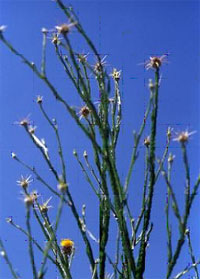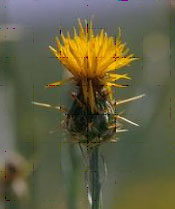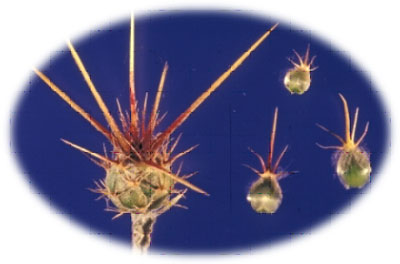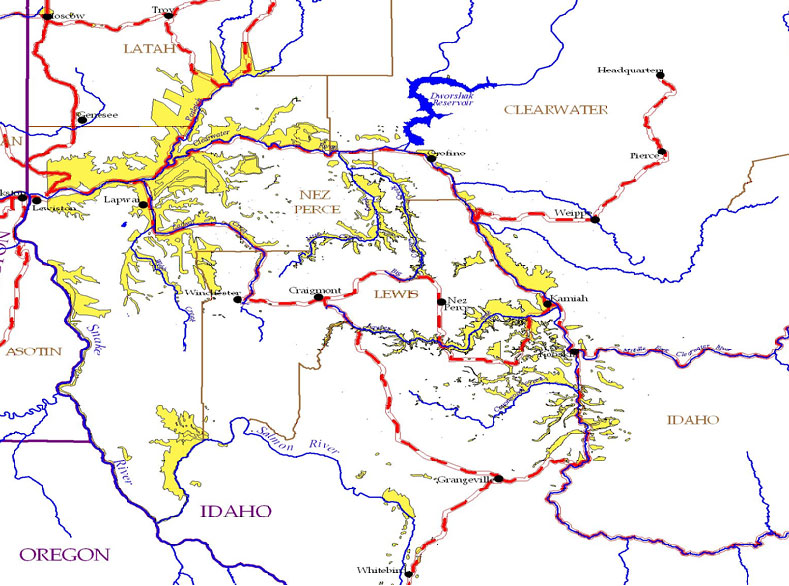Yellow starthistle (Centaurea solstitialis) is an invasive plant of rangelands of the western United States. It is a native of the Mediterranean and was first detected in California in the early 1800's. For more information on this invasive species go to the National Invasive Species Information Center. Information for yellow starthistle was adapted from the Colorado Weed Management Association’s web site.

Figure 1. Yellow starthistle plant. Photograph: Mark Schwarzlander, Univeristy of Idaho, Bugwood.org
Figure 2. Yellow starthistle flower. Photograph: Laura Parsons, University of Idaho, PSES, Bugwood.org

Figure 3. Yellow Start Thistle Seed head. Photographer Steve Dewey, Utah State University, Bugwood.org.

Figure 4. Yellow Starthistle Distribution in Nez Perce County. Yellow shaded areas show distribution areas.

Nez Perce County Distribution:
Yellow starthistle is prevalent within Nez Perce County’s rangelands, roadsides, pastures, recreation lands, and cropland. The plant does not tolerate shade and requires light on the soil surface for winter rosette and taproot development (FEIS 1998). The weed will establish on deep, well-drained soil as well as shallow rocky soils. In the Pacific Northwest, yellow starthistle favors sites that were formerly dominated by big sage-brush, blue bunch wheatgrass, Idaho Fescue and Sandberg bluegrass (Sheley et al 1999).
Nationwide, USDA reports the weed in forty-one states with the highest concentration in California.
Impacts:
- Horses can develop chewing disease (equine nigropallidal encephalomalacia), a neurological disorder, when grazing yellow starthistle (Maddox et al. 1985).
- Yellow starthistle establishes on disturbed soils and reduces the amount and availability of edible forage.
- Yellow starthistle exhibits a suspected allelopathic effect on some associated species (Maddox et al, 1985).
Biology:
- Seedlings emerge in the fall, form rosettes, and begin growing a taproot. Root growth continues throughout the winter. Yellow starthistle bolts in late spring and flowers June through August.
- Mode of reproduction: It reproduces entirely by seed (FEIS 1998).
- Plants usually produce 700 - 1,000 seeds/plant, but vigorous plants may produce up to 170,000 seeds/plant (Herzog and Randall 1998, FEIS 1998).
- Seed bank: Seeds may remain viable for several years (Herzog and Randall 1998).
- Dispersal: Plumed and plumeless seeds are dispersed at different times. Plumed seeds are dispersed by wind shortly after maturity.
- Plumeless seeds remain in the seedhead until it disintegrates in the fall or winter.
CONTROL
Controls include herbicides and bio-control agents. Herbicide applications are very expensive and often difficult to apply in steep terrain. Biocontrol agents are a low-cost long-term alternative.
References:
- FEIS - Fire Effects Information System [Online] (1996, September). Prescribed Fire and Fire Effects Research Work Unit, Rocky Mountain Research Station (producer), US Forest Service. Available: Fire Effects Information System [1998,March 12]
- Hastings, M.S. and J.M. DiTomasso. 1996. Fire controls yellow starthistle in California grasslands. Restoration and Management Notes 14:124-128.
- Herzog, P. and J. Randall. 1998. Element stewardship abstract for Centaurea solstitialis, yellow starthistle. The Nature Conservancy. Available 7/30/98. Internet: http://tncweeds.ucdavis.edu/esadoc/documents/centsol.html
- Maddox, D.M., A. Mayfield, and N.H. Poritz. 1985. Distribution of yellow starthistle (Centaurea solstitialis) and Russian knapweed (Centaurea repens). Weed Science 33:315-327.
- Sheley, R.L., L.C. Larson and J.S. Jacobs. 1999. Yellow starthistle, In: R.L. Sheley and J.K. Petroff (eds.) Biology and management of noxious rangeland weeds. Oregon State University Press, Corvallis. pg. 408-416.